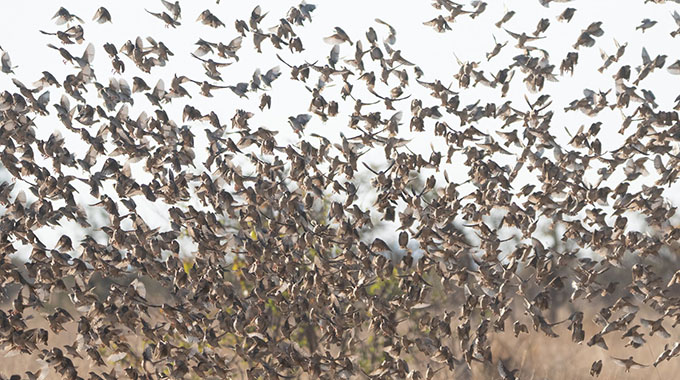Zimbabwe: Drone technology gains traction in quelea bird control

Sifelani Tsiko-Agric, Environment & Innovations Editor
The use of drone technology and better coordination has contributed to greater success in minimising damage to this year’s winter wheat crop by ravaging huge flocks of quelea birds, a senior Ministry of Lands, Agriculture, Fisheries, Water and Rural Development official says.
Department of Migratory Pests and Biosecurity Control acting director Shingirayi Nyamutukwa told The Herald on Thursday that the use of drones, closer collaboration by key stakeholders and adequate chemical supplies had led to success in quelea bird control this season.
“The harnessing of drone technology coupled with better coordination of Quelea Command Centre helped protect much of the winter wheat crop,” he said.
“The success in Quelea control was achieved through improved coordination between Migratory Pests and Biosecurity Control Department (MPBC) and Parks and Wildlife Management Authority operating from 5 logistical points in Zimbabwe namely Harare, Bindura, Darwendale, Birchenough Bridge and West Nicholson.”
Nyamutukwa said timely deliveries of chemicals (Fenthion 640 ULV) to outbreak areas played a critical role in fighting quelea birds in roosting sites dotted across the country.
“Updates were given through the group (Quelea Command Centre) encouraging reporting. Throughout this 2022 winter wheat season, a total of 317 reports were made with a few coming in from those who planted late,” the plant pest control expert said.
“However, not all reports were of quelea outbreaks with seven of them being outbreaks of other birds, though in small populations.”
The biggest number of quelea bird reports – 36 percent – came from Mashonaland West – a hot spot of quelea bird outbreaks.
This was followed by Mashonaland Central with 14.2 percent, Matabeleland North 13.9 percent, Mashonaland East 10.7 percent, Masvingo 8.2 percent, Midlands 7.9 percent, Manicaland 7.6 percent and less than 2 percent from Matabeleland South.
Zimbabwe’s record winter harvest this year is five times more than the produce that was realised in 2021.
The country is 380 000 tonnes from 79 000 hectares of winter wheat.
This required consolidated efforts to safeguard the crop from ravaging quelea birds.
To deal with the quelea bird menace, the teams used several strategies that included chemical control using Fenthion 640 ULV applied through four ways – tractor-mounted sprayers, motorised back-pack sprayers, aerial sprays and drone application, physical trapping using nets, bird scaring using vuvuzelas, long sticks and noise instruments.
“We are planning to promote other non-chemical ways of controlling the birds such as netting and harvesting hatchlings during breeding season. We also want to harness drone technology to drive away birds amongst a range of other available options,” Nyamutukwa said.
“Already we are preparing for surveillance during the breeding season and procurement of chemicals is underway in preparation for the small grains production in support of all small grain production nationwide.”
Zimbabwe has adopted the use of drone technology in pests and border control.
The use of drones to complement knapsack spraying has been adopted to improve efficiency and reduce costs.
Teams from the Department of Migratory Pests and Biosecurity Control have been on the ground for several weeks controlling quelea breeding colonies in Muzarabani, Gonarezhou, Deka and Mbire to help manage the tiny species that flock in huge numbers attacking vast tracts of grain crop fields.
Quelea birds are the largest contributor to heavy wheat losses annually estimated at over 95 percent if uncontrolled.
The birds have been a threat to summer subsistence small grains and commercial winter cereal cropping in Zimbabwe for years.
Each tiny bird can feed on four grams of wheat per day and experts say a million birds can result in losses exceeding 40 000 tonnes when the quelea birds invade fields in large flocks.
The red-billed quelea is a small weaver bird native to sub-Saharan Africa and renowned for its attacks on small-grain crops within Africa. It is the most numerous bird species in the world, with a peak post-breeding population estimated at 1,8 billion.
Nomadic super-colonies can grow to millions of birds, making quelea not only the most abundant bird in the world but also the most destructive to cereal grains, especially sorghum and millets as well as wheat, rice and barley.








Comments